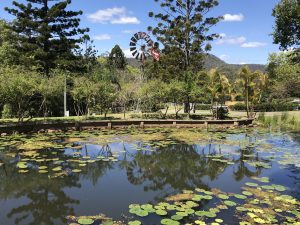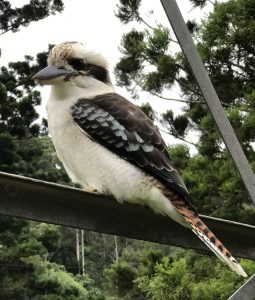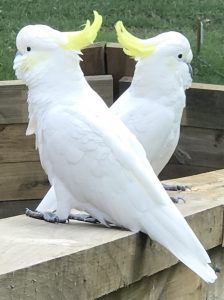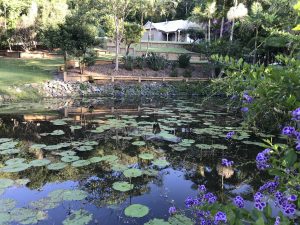FAQs
Frequently Asked Questions
Below are many of the most common questions we get asked. If your question is not covered here, please feel free to ask your question on the form provided in the special section of Ask Our Budgie Whisperer A Question
owning a Budgie
The golden rule with budgies is always to have two budgies or more. Budgies differ because of their communal flock nature and instinct to socialise. Budgies will still bond to their owners regardless of the number of birds in the cage. In our aviary, it’s not unusual for us to have 4-6 birds sitting on our shoulders when we go into the aviary each day; we have not gone out of our way to bond with them; they recognise that we feed them every day, change their water twice a day, clean their nest boxes every day and bring them treats usually in the form of wild grass – they have bonded to us regardless of their numbers!
To try and explain why a budgie needs to bond with its own kind…. in the wild budgie world, the flock survives because of the sheer size of the flock and socialising and bonding is part of their natural survival instinct. If you go to the areas where budgies live in the wild, you may see 1000 budgies and 10 trees, it is not unusual to see all 1000 budgies in the same tree, by choice, for comfort, safety, and survival. That instinct to bond and colonise has been bred into them over thousands of years
Single budgies get lonely when left alone, and it shows in their ‘quietness and stillness’, which is usually a sign of stress caused by loneliness; it also shows in their longevity (the number of years they live). Happily bonded budgies in our aviary can live for 15 years; a lone budgie rarely lives for more than 5-6 years and is often found dead one morning with no apparent cause – a broken heart is not always apparent!
Often, when we sell a budgie to a customer who has an existing budgie and wants a partner, they report back to us that after introducing the second bird, they see an immediate and amazing improvement in the general happiness of their existing budgie. We have hundreds of lovely photographs from happy customers who are proud of what they have done for their lone budgie by finding it a mate. The advantages don’t just stop there; the lone budgies’ general well-being and health improves as a bonus for the owner and the budgies generally also become far more entertaining to watch
If you have a single budgie, you must interact with it every day. That does not mean that the bird has to be on your hand for long periods, but it does involve talking to it, walking around with it on your shoulder, offering things like small toys to investigate, etc. These are all ways of interacting. If you only have time to play with your budgie for a few minutes a day because you are off doing other things, what does your budgie do for the rest of their time? That is why budgies need partners because in practice, most people don’t have those hours every day to spend with their budgies! The second budgie is the simple solution
There is an exception to the rule for people who buy a lone budgie as a daily companion and have all day to give attention to that lone budgie. In this case, the lone budgie will have its time well occupied and will usually be content and will also be doing a worthwhile job at the same time by being a loving companion to a lone person
If you already have a single budgie, we offer a free budgie matching service where we take your budgie and introduce it to a potential partner or two. We believe in letting budgies make their own choice in life partners, and it gives us great pleasure to hand you back two budgies that will be friends for life. You only pay for the new budgie; the service is free.
If you have a mature budgie that has lost a partner, PLEASE act quickly to introduce them to another partner; even in old age, budgies will re-bond quickly due to their instinctive social behaviour. A budgie that has lost its life partner can grieve to the point of losing appetite and eventual death. Get them introduced again as quickly as possible. We keep a supply of mature birds specifically for those who have lost a partner
When introducing a new partner, you will normally find it better to introduce one of the opposite gender. They tend to bond immediately, and it’s lovely to see the budgie you love find its love with a partner of its species. It won’t detract from their love of you. Under normal circumstances, budgies will not breed if no nest box is provided
In our opinion, the golden rule is, unless you can be with your budgie all day, PLEASE get it a friend – you will see the happiness in the birds, and you will be very glad you did the right thing. If you have a lone budgie and have the time to give it all the time it needs, and it appears happy and contented, there is no reason to change anything. Be proud of yourself for giving your budgie that much time and love
If you are starting with budgies for the first time, please buy two or more and experience the real pleasure of having ‘heavens angels’ entertain you, doing acrobatics, showing off and giving back to you every ounce of love you give them
One last important point and this is very important: if you still prefer to start with a single budgie, please take your time to select one that is outgoing and lively. A boy would be preferable as they tend to be slightly more dominant, which helps with the budgie’s transition to lone life. In our selection of 500 + budgies, there is always a great choice of budgies that stand out with their character and level of confidence, and these will always give you the best chance of being successful in their transition to a lone life. The quiet one in the corner may look very cute and be a great choice to go with a partner, but they need help to do well and usually become very lonely very quickly
In summary, be the best friend to your budgie and make sure it has a friend of its kind for life. Look into your heart and let your budgie have a love of its own and yours
It is always better to buy two budgies rather than one; however, if you can only buy one then generally, make it a male as they tend to be slightly more outgoing and active, which they will need to be to be happy in a single life situation. Still, please read our previous comments before you buy just one
You can buy two males, or a male and a female. You will not usually have any bonding issues with either choice, but we recommend always buying one of each as it’s nice to see the romance between a male and a female; it’s so cute!
Budgies are clever; they will only breed if they have the right facilities to raise a successful brood of babies. That means that they need a nest box to be successful and as long as you do not provide them with a nest box, they will not breed. It is always possible although rare for a female to lay an egg in the cage if she becomes hormonal; that is just an accident of nature. Remove it if this is the case, it should not happen again
Always pick the ones that are beautiful to you; there is no realistic way for you to pick the best budgie in a cage of maybe 15 budgies and there may be many cages to look at if you are at a good breeding facility. Even if you had three experts with you, chances are that those experts would all disagree on which ones to pick! Pick the ones that look beautiful – let your heart rule your choice
Never buy a budgie from a place where you cannot see the conditions in which the budgies have been bred. You must be able to see if the budgies have been raised in high-quality surroundings by knowledgeable people, then you are likely to get good quality budgies with a long life expectancy. Don’t feel committed to buying because you have visited somewhere and taken a little of the seller’s time. Use your eyes and your nose. Is the premises clean? Does it smell fresh? Are the cages cleaned daily? Are the premises well-lit with good ventilation? Is there fresh food available and are the water containers clean and filled with fresh water? Are the floors clean enough for YOU to eat off? Can you see the parents of the budgies? If you cannot see where the birds have been bred, then chances are that that is because you would not like what you see! Move on – choose carefully, and don’t be embarrassed to walk away. Buy from somewhere where you know it’s the right place. Check out the seller’s references on Google; if they do not have any references, guess why that might be!
Yes, you should, but if your existing budgie is older, you need to take a little care. They can become territorial and possessive under some circumstances and may not always welcome a partner of the same sex. However, a partner of the opposite sex is usually welcomed. Here at Whispering Pines Aviary, you are welcome to bring your existing budgie with you so that we can see how it reacts to other budgies. We are great believers in letting a mature budgie pick its partner, it has earned that right. Nothing will give you more pleasure than seeing you leaving our aviary with your lone budgie snuggled up against its new partner!
If you buy a not-hand-tame budgie, you may have more work than you think. We start hand training our baby budgies from a very young age, while they are still in the nest box at about 4 weeks old. It, therefore goes without saying that if you buy an untamed budgie from another source, it has missed out on all of that training at a younger age and being ‘untamed’ would have become instinctive to the bird. After we have hand-tamed a budgie, we can put it back into a cage and not handle it for some time; when we take it out, the hand- taming kicks in within minutes because it has become instinctive to the bird. In short, you pay a little more for your budgie to be hand-tamed, but it is well worth the investment, especially considering the pleasure your feathered friend will give you over the years
You have a wide choice of where to obtain your new budgie family member, but you need to be careful! A mistake in the choice of where to buy can leave you with large vet bills and very bad memories!
Many breeders dispose of their unwanted, or substandard stock, into the pet market, and you should be very careful and fully aware that a cheap budgie from an unknown background, could well end up costing you a lot of money in expensive vet bills! So how can you avoid that situation?
Firstly, never buy a budgie without seeing the situation in which the budgie has been bred.
Read that line again – This is very important! Ask to inspect the aviary of the seller. Is it clean, protected from the elements, do the birds have good lighting and natural sunlight, clean food and water containers, good ventilation? Are the floors and walls and wire cages clean and look as if they are cleaned every day or so? If not – move on – look elsewhere for the sake of your budgies, you should not settle for second best when you do not need to.
Beware of pet shops who buy in low-quality babies that they can sell cheaply. Also beware of amateur breeders who have just bred a couple of budgies for fun in the back yard. They may well have cramped small cages where the birds cannot fly and will be offering you a complete lack of choice in colours and temperament. Don’t limit your choice, if the seller can’t offer you at least 50 babies for you to choose your perfect baby budgie from, move on – look elsewhere.
Make sure that you are 100% happy with the breeding setup and then ask to see the budgies parents. Are the birds in good health, in prime condition, living in a good size enclosure, look vibrant and happy? If not, although the babies may look very cute, you are probably NOT going to be very happy with the long-term issues and challenges you may have to face with the budgies you have chosen. There is no need to take risks, if you have doubts – move on – look elsewhere.
Make sure that the baby budgies you are looking at are hand tame (unless of course you are going to put them into an aviary and you are not going to handle them). Most people can’t provide the correct training to hand tame a budgie, and even if they manage it, it may take a very long time. If you are going to handle them and let them out in your home, make sure they will sit happily on your hand and shoulder and that they will ‘step up’ from one finger to another before you buy.
What is the point of buying a baby budgie that is not tame and that you may never be able to tame? The supplier should have done this for you and should be happy to help with advice on the budgie and the human bonding process. They should be happy to spend time with you, to show you how tame the budgies are and how you can take over the role of best friend.
At Just Budgies at Whispering Pines Aviary, we recommend buying your budgies from a professional and well-educated place and not an amateur set up. ’Just Budgies’ will hand tame a bird for you that you have acquired elsewhere but the cost will be the same as buying one of our hand tame budgies and so buying a cheap budgie that is not hand tame, is not such a bargain is it! If you then factor in the treatments, wing feather trimming and other benefits that you get included with all Whispering Pines budgies, then what we charge, is quite a bargain.
Look at this another way, you think nothing of spending an extra $20-30 for a nice cage or toys for your baby budgies, so spend that little extra money to make sure you start off with a beautiful, quality, hand tame, healthy budgies. Does that make sense to you? It should do – its pretty well common sense really. Start off right, start off with quality beautiful budgies that your friends and family will be envious of. Budgies are one of the best small pets in the world, give them that respect and they will love you for years to come.
Yes, they are, but control and rules must be in place. A child especially under the age of about 7 should be supervised with a budgie; they do not have the handling skills or pick-up skills of an adult and can easily damage a budgie. Budgie legs and wings are fragile, and with normal adult handling, there should never be a problem, but young children do not have adult skills so be careful. Ensure your children are supervised with strict rules until they are well- practised at handling
Caring for your budgie
Be kind; give them a little rest. they have been pulled out of their community cage, held, wings trimmed, put in a box, driven home, put into a strange cage in a strange place and strange faces are looking at them. Just give them a few hours to settle in and bond with each other, their cage and their surroundings before you attempt to bond with them. Start your bonding the next day if you have locked them up late in the day or the same day but later on, if you picked them up early in the day, do not leave it longer; it is important to start the bonding process after they have rested. Following that, you should handle your budgies every day
Avian scientists and nutritionists have discovered that the best diet for budgies is a fresh diet in addition to seed, which is far better than a restricted diet or just seed. We recommend a ‘chop diet’ which includes vegetables, sprouts and salads to accompany the seed. A good chop diet may consist of any of the following: try and make it as mixed and varied as the seasons and prices allow…. This is our suggested chop food diet; pick the items that you normally eat or are in season; these should be uncooked and washed. Also please remember that each budgie might eat only 1-2 teaspoons; they can’t eat a whole bowl full!
Broccoli – Cauliflower – Celery – Brussel Sprouts – Capsicum – Chilies (great nutritional value and the bird cannot feel the heat) – Squash – Spinach – Herbs – Sweet Potatoes – Carrots – Bird-safe edible flowers – Mixed sprouted seeds – Mung beans – Small amount of non-citrus fruit like apple once a week (budgies are not big fruit eaters) – Hard-boiled egg once every 7-10 days – Fresh hand cut grass
Seeds are important but in moderation; although seed is easy when you are busy, seeds alone will leave the birds nutritionally deficient. You need to be careful; budgies in the wild tend to seek out Spinifex grass and feast on those seeds. The thing with Spinifex grass is that it has low-fat content. Most seeds you buy in a shop supposedly for budgies are loaded with canary and finch, which are high in fat because they are cheap. Although canaries and finches can take that seed, budgies cannot and often fatty liver disease is the resulting problem and is usually terminal!
Remember that seeds are nutritionally incomplete, lacking vitamins, minerals and protein; they should therefore only be a small part of a budgie’s diet and should never be the entire diet. Please realise that a seed-only diet is the same as feeding a child 3 burgers daily. be warned, it can be fatal, and although it can be treated, it is expensive and could have been avoided with a balanced diet
In addition, offer your bird seeds but healthier options from the ‘chop foods’ list above. Your bird will eventually start eating more properly balanced foods, giving them a healthy diet. No to a food item one day – does not mean no forever – KEEP TRYING! We sell specially mixed seed for budgies that is five kinds of millet and is exceptionally low in fat. It is called Budgie Specific Diet Mix and is the best seed you can buy. It costs very little more than the high-fat shop-bought alternatives, and we can post the seed to you if you do not live close enough to collect
When you buy budgies from any source, make sure they have been treated for mites and worms and ask for a certificate to have a record of the dates of treatment. Re-treat again every six months. It is very simple: just a quick spray underneath the wings (protecting the budgie’s nose so it does not breathe the vapour in) and a few drops of worming fluid in its water. It takes seconds and costs very little. Also, consider putting vitamin drops in the water every week, and it does not hurt to keep a jug of vitamin water in the fridge so that they get it every day when you change the water. Otherwise, budgies require very little maintenance, a good diet, exercise, and quick treatment every six months and that is it
If you see anything unusual, particularly if the bird stops eating, let our treatment rooms at Whispering Pines immediately know. do not delay; budgies only have a very short illness period. We carry modern medicines for most treatments; they are very effective and successful if started early enough
The cost of a visit to our treatment rooms is just $25 if you did not buy your budgies from us and completely free of charge for the first two months if you did buy your budgies from us. If budgies need to be kept in for treatment, the cost is just $7 a night if you did NOT buy your budgies from us and free if you did buy your budgies from us
If you decide to go to a vet instead, make sure it is an Avian vet and get a quote for the visit and treatments and any stay-over that may be necessary so that you do not get a shock bill at the end. You should always know what costs will be in advance
Ask if the budgies have been treated for mites, vitamin protection and wormed. If the answer is positive, then ask to see evidence of this, the supplier should be able to show you the treatments they use and also be willing to provide you with a certificate of treatment on request. Here at ‘Just Budgies’ at Whispering Pines Aviary, we use Avitrol Mite Prevention, Vetafarm Soluvite Vitamin D and Aristopet Avian Wormer as our basic treatments and are happy to provide you with a certificate on request. Talking about certificates, did you know that….
We can also provide a free budgie birth certificate detailing the hatch date and details of the parentage of your baby budgies. If the budgies are a gift for a child, we will also put the child’s name on the certificate showing their ownership of the budgies as a very special memory. At Just Budgies at Whispering Pines Aviary, we go that extra mile to make your purchase something special for you and your family.
This is just one of the reasons that so many people choose Just Budgies – we show we care with the things we do that we do not need to do! It’s called good old-fashioned customer service and no, it is not a thing of the past in our business
Absolutely! We see so many cases every week where budgies have been purchased, taken home, released from the cage and broken their necks flying into the glass. Budgies must always be allowed to fly; they are birds and need to fly; it is their instinct. However, a budgie with untrimmed feathers will fly at 20-25 kph, but once the feathers are trimmed it is down to 7-8 kph, and that means that unless there is a freak accident, they are safe. If you sit your budgie on a benchtop and make it fly after its wing feathers are trimmed, it should fly downward, not upwards. It should fly 5-6 metres and then glide to a standing position on the floor. This also gives you a chance to pick them up if they escape through a door or window but be aware that budgies fly much better outside than in due to wind pressure
The problem is that most pet shop staff have never been trained to trim wings; most vets who are not speciality avian vets have not either. We have seen some appalling mutilations of budgies wings so finding the right place to get the wings trimmed is critical. We have even seen just one wing trimmed so the budgie is completely unbalanced, shocking unnecessary cruelty. We trim wing feathers free of charge, and if you revisit us after a few months, it is still free. We do that because we have a love for budgies. Please don’t take chances and don’t try it yourself without expert tuition. Google does not make you an avian expert. It is a real skill to get the trim and balance right
In most cases, yes we can. It can take a few days, and your budgie will need to stay with us, but we have ways of changing budgie behaviour, and we are successful in most cases. Contact us for more details
NO! Do not even think about it! Find a budgie sitter; your budgies deserve the same service with fresh food and water as you do. We offer a full 5 star budgie sitting service; see our section on this website, ‘Holiday Time Bird Sitting.’ Let them be spoilt while you are spoiling yourself on holiday! The cost for two budgies total is just $7 a night or $40 a week or $140 a month, and they get a free health check while they are here!
Cages & Equipment
Beware of pet shop toys; the rope of some of these toys will be chewed and ingested and can lead to death. Pet shops know this and continue selling them, which is so shameful. Choose toys that move; they love swings, ladders, and things on which they can show off their agility. Plastic toys like the ones shown in our Cages & Accessories section are fine but don’t forget that they get as much fun out of a small handful of hay or grass, small twigs, pine cones, branches with a few leaves, etc. In other words, they love natural surroundings, so make your cage more like nature!
What size house is good for humans? This is a difficult question to answer and largely depends on whether the budgies will be in or out of the cage for long periods. A minimum size cage for 2 budgies is said to be 60 x 40 x 40cm, and for 2-4 budgies then say 76 x 44 x 44cm, and for 4 or more, then a larger cage with a stand is useful say 144 x 61 x 42cm – You will notice that the cages we sell all have a flat top, that is because you can then sit a playground on top so that the budgies have a base while they are out of the cage which budgies love. All of these cages, playgrounds, toys and more are shown in our Cages & Accessories section on this website, and there are some amazing bargains for a cage and budgies combined purchase. Check it out!
Look at our ‘Cages & Stands’ section of this website; you will see pictures of cages with the correct proportions for budgies. Length of perches, correct access, and door sizes are important for hand-tame birds. Do not be tempted to buy from the internet or a pet shop where little or no knowledge and advice is available and often, sadly the wrong advice. PLEASE come to see us first; you will be so glad you did. We have the right cages at the best prices, all setup, tested, and ready to use. It is a very sad customer indeed that visits us having bought their cage elsewhere and then realises what they have missed out on
General Questions
A baby budgie leaves the nest box at about 6 weeks old and at this age, it is very difficult to be 100% sure what gender is. All babies are born with their cere (the bit above the beak where the nostrils are), purplish or pinkish. Over the next few weeks, this purply pink turns to either blue for a boy or white / cream for a girl. The girl’s cere can turn brown after a few more weeks or months, usually when she becomes hormonal
In some 8-week-old babies, we can already tell because the cere’s colour has changed early. In other babies, we can give an educated guess on the gender of a baby budgie based on our experience, and we normally get it right, but there are sometimes exceptions. Some baby budgies colour are slow to colour up, and this can leave doubt about their sex. With young budgies, don’t get hung up about the sex; choose the ones you fall in love with!
For many seed-only fed budgies, 5-7 years is the average. You could double that lifespan if they are fed a mixed chop diet of fresh veggies daily and protein. We feed our budgies hard-boiled eggs once a week, giving them all the protein they need for a long and healthy life; some budgies are 15 years old! Just hard boil an egg, finely chop it up small and if you like, mix a little finely chopped celery or broccoli in with it and put a pinch of seed on top. They go crazy for it! A whole egg with chopped additions will feed 10-12 birds so you can use part of your own egg that you are having for breakfast!
Don’t give up on a budgie with ‘problems’ !
Although problems with budgies are quite rare as budgies are remarkable birds who love human interaction, we sometimes hear from owners whose budgie has ‘issues’. Sometimes they report that their budgie is not tame, too quiet, too noisy, unsocial or biting, has no partner, shedding feathers, has suffered damage or a trauma or partner loss and so on. PLEASE do not give up on your budgie if this is the case, the cure is normally quite straight forward and just requires a little knowledge and intervention to rectify the issue.
In the case of a budgie being untamed, won’t sit on the hand, bites and generally can’t be let out of the cage, the problem is usually just a simple lack of knowledge on the part of the owner and at Just Budgies at Whispering Pines Aviary, we can take your budgie and for a small cost, we can hand train it so that you are able to let it out of the cage to enjoy life. This usually deals with any antisocial behaviour automatically as a happy budgie, is rarely an antisocial budgie.
Feather loss and general ‘quietness’ can be down to a number of things but depression and loneliness are at the top of the list for a bird that lives by itself. That can easily be rectified by introducing the existing bird to a new partner and that is something that we specialise in as we offer a full introduction service to find your lone budgie a lifelong partner. Sometimes, a lone budgie can just forget how to be a budgie and after all how would you feel after months or years by yourself in a room with no other humans? When introduced to another budgie, the change in the lone budgie is remarkable and often sensational, it’s also lovely to watch, especially when you see the bonding that forms between the birds!
Where trauma has been experienced as was the case with one of our customers Karly & Hannah who unfortunately suffered an oven fire in their home which their two baby budgies were traumatised by with smoke and the noise of fire alarms. The baby budgies just cowered in the bottom of their cage, too frightened to even be handled. We were able to take the babies and within a week, return the same two beautiful baby budgies to their owners who were who were so happy to be able to handle their budgies again.
Where the budgie is just antisocial in behavour, its lovely to watch a ‘problem’ budgie go through our socialisation programme and this is sometimes achieved by putting the antisocial bird into a confined space with 10-15 other budgies that we borrow from our aviary for a couple of hours. In the photo you can see the middle budgie that was antisocial through lonliness and after just two hours with a budgie ‘flock’, it had found its pecking order or position in the flock, made friends and within another two hours of hand taming, became a lovely pet along with its new friend. This made sure that the budgie never became antisocial again, simply because it was now happy.


Set in over 8 acres of manicured grounds with windmill, dam, rock pooled creek, forest and abundant wildlife, this is the place you would want to spend some time to select your budgies….

Be prepared for the selection to take you a while, with over 120 budgies to choose from and with every colour and character you can imagine, it is not going to be easy to choose, and while you are looking, the wildlife, parrots, Kookaburras, kangaroos, possums may well entertain you….

If this looks like the kind of place to breed the healthiest, most colorful, tamest budgies around, then text or phone on 0412 993 334 for a day and time to make your visit. Your budgie family awaits you.

Still looking for answers?
Ask your own question here

